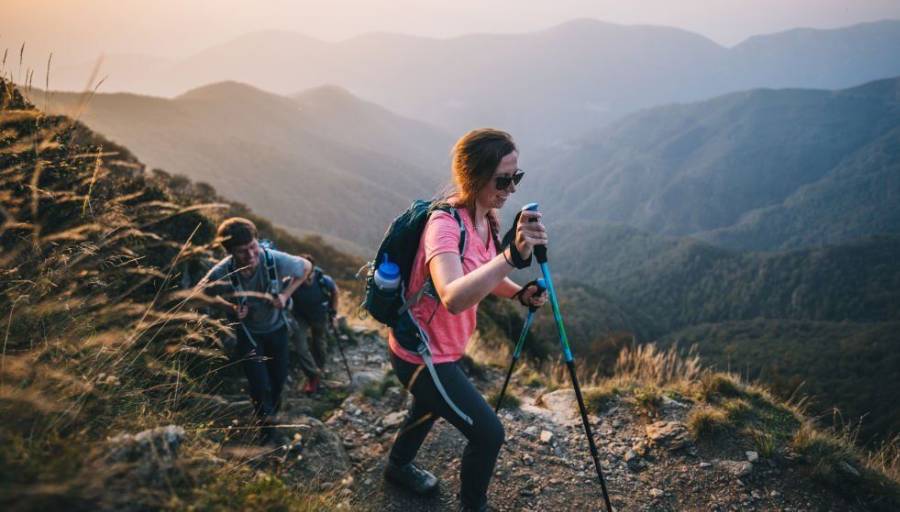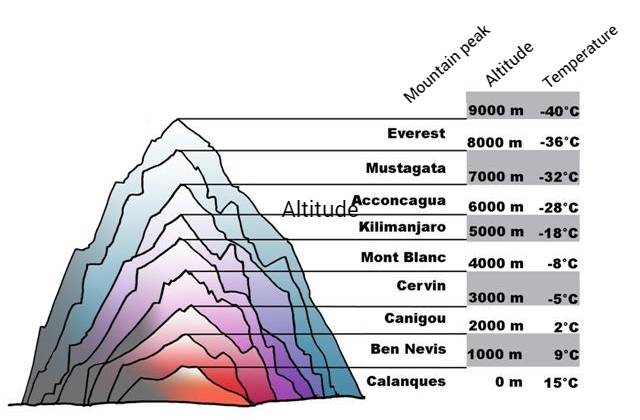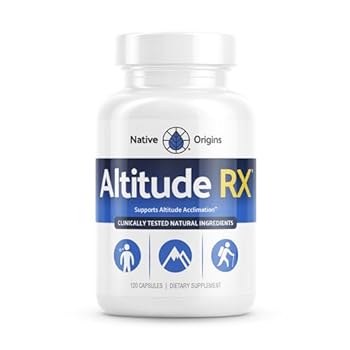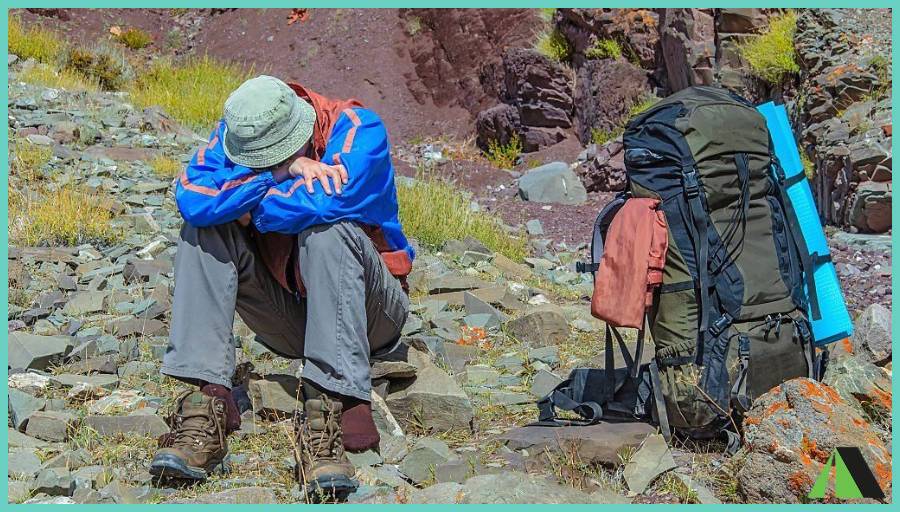
If you’re accustomed to hiking in high mountainous regions, you’ve likely encountered or at least heard of altitude sickness. It could even be a personal experience during a high-altitude trek, as it is a prevalent challenge in mountainous environments. This condition can potentially impact individuals of all ages, from infants to the elderly, and typically manifests its initial symptoms at altitudes around 2000 meters.
It is now well documented by medicine whether the ailment is mild or acute. Also, you can prevent the appearance of the first symptoms by respecting a few rules. Finally, a multitude of solutions to cure altitude sickness are readily available and easy to implement. I invite you to peruse my comprehensive guide on How to Deal with Altitude Sickness While Hiking.
Explanation of Altitude Sickness
Altitude sickness is a rarity among individuals residing at high elevations due to their bodies’ acclimatization to reduced oxygen levels. Conversely, it frequently afflicts those ascending rapidly without undergoing the necessary acclimatization stages, particularly beyond the 2000-meter mark.
Let’s see together what medical science has to say about this phenomenon and its symptoms.
Medical Definition
According to the MSD manual of medicine, altitude sickness is due to the lack of oxygen experienced at high altitudes. You probably know that the higher you go, the lower the atmospheric pressure. However, the concentration of air also decreases, which is why you have more difficulty breathing as you climb to the top of the mountain (see figure 1).

Thus, altitude sickness usually appears around 2000m altitude when you only have access to about 80% of the usual oxygen level. From 2500m, 20% of people develop altitude sickness. This rate even reaches 40% at 3000m altitude and 90% above 5300m altitude.
Common Symptoms
You are starting to develop altitude sickness if, during your hike, you experience these symptoms:
- Headache
- Fatigue
- Loss of appetite
- Nausea, difficulty swallowing
The Most Serious Cases
The longer you stay at altitude, the more you will accentuate your altitude sickness if nothing is done. In some cases, this disease can be dangerous or even fatal.
Here are the most serious symptoms that can occur:
- Irritability and dizziness
- Discomfort
- Coma
- Cerebral and pulmonary edema
Of course, cases of acute altitude sickness are extremely rare at an altitude of 2000-3000m but become more common above the famous limit of 5300m altitude. But don’t worry, because it is possible to prevent this common evil or even to cure it when serious forms are to be feared.
Some Tips to Prevent Altitude Sickness
Understanding the aggravating factors is key to preventing the progression of altitude sickness. While complete prevention may not be guaranteed, this knowledge enables the mitigation of its effects and helps avoid the onset of severe altitude sickness.
Here are the factors of the appearance of this evil:
- A high-altitude climb too fast without making adaptation stages
- Excessive physical activity at high altitudes
- Too low a concentration of red blood cells in your blood due to your daily life near sea level
- Previous altitude sickness
Based on these observations, it is easy to prevent altitude sickness with a few adapted behaviors:
- Do not climb from 0m to 3000m altitude in a few hours or do not stay more than 4 hours on site.
- Make adaptation levels from 1500m altitude, staying 2 or 3 days on site. This will promote the creation of red blood cells to increase the distribution of oxygen in the body.
- Restrict your movements to what is strictly necessary from an altitude of 2000m to save your oxygen and your energy.
- Avoid drinking alcohol or taking sleeping pills, which increases the risk of the onset of mountain sickness.
- Taking prescription medication: If your doctor thinks it is necessary, he or she may prescribe a medication called Diamox, which will help your body acclimate more easily to the lack of oxygen. Available on prescription, it is recommended for people who have already suffered from acute altitude sickness but also to prevent edema and sleep disorders. Like any drug available on prescription, Diamox must be ingested on the advice of your doctor. Avoid any self-medication that could be dangerous.

As soon as you arrive at a high altitude, at 3000m, I do not recommend climbing more than 500m per day to give the body time to adapt to the new conditions. Every 3 days, plan to spend 2 nights in a row at the same altitude so that you can avoid rushing your body. Finally, avoid paracetamol-based medications such as Doliprane, which mask the symptoms of altitude sickness but do not cure it in any way!
Acute Altitude Sickness: How to Eliminate the Symptoms
After examining preventive measures to deter the onset of altitude sickness, let’s now explore how to address this ailment when initial symptoms arise. In any case, the goal is to prevent mild altitude sickness from escalating into a more severe, potentially fatal condition.
First Reflex: Stop the Ascent
It sounds obvious, but many hikers ignore the warnings their body sends them. As soon as the first symptoms appear (migraine and great fatigue), you must stop your ascent in its tracks. The appearance of these symptoms is a sign that your body is suffering from the lack of oxygen.
By continuing to climb, you would put him in more danger and promote the appearance of more serious symptoms such as malaise and nausea.

Step Two: Rest
Fortunately for us, our body knows how to acclimatize to new and difficult conditions. When symptoms appear, take rest and give your body time to produce red blood cells which are necessary for the transport of oxygen. Set up a tart at your own pace without rushing your body; then wait between 12h and 3 days.
After this time, you have two possibilities: either the symptoms persist, in which case you will have to descend, or they have gone away and you will be able to continue the ascent carefully. For the second hypothesis, think of the system of levels of 500m per day!
Third Step: The Need to Come Down
Despite these 3 days of rest, the symptoms persist. Worse, they get worse sometimes. You must then descend a minimum of 500m to help your body catch its breath. Then take a rest and wait again for 12 hours. If it doesn’t improve, you’ll need to descend to low altitude to seek medical attention. If deemed necessary, a medical professional can prescribe medication to aid in the reacclimatization of your body, facilitating the disappearance of altitude sickness symptoms within a few days.
Finally, in the event of significant edema, the emergency services will be able to treat you based on corticosteroids and calcium channel blockers to reduce your swelling. In any case, taking such drugs without going down would be useless!
Frequently Asked Questions
What is the best cure for altitude sickness?
Treat Altitude Sickness:
- Stop and rest where you are.
- Don’t go higher for at least 24-48 hours.
- If you have a headache, take ibuprofen or paracetamol.
- If you feel sick, take medicine like promethazine. Be careful, not to mask the symptoms to start again better, stop at least 24 hours!
- Make sure you drink enough water.
- Do not smoke, drink alcohol or exercise.
How long does it take to recover from altitude sickness?
Symptoms of moderate altitude sickness usually improve within 24 hours at an altitude below 1000 meters. Symptoms should disappear completely within 3 days. People suffering from acute altitude sickness should be immediately taken to an altitude below 1200 meters.
Does drinking water contribute to altitude sickness?
It is important to stay hydrated at altitude. Symptoms of dehydration are similar to those of altitude sickness. Count one liter to one and a half liters of additional water per day at altitude. In this case, I recommend you bring a good quality filtered water bottle. Clear urine indicates adequate hydration, dark urine suggests dehydration and the need to drink more water.
How serious is altitude sickness?
Dizziness, nausea, headache, and shortness of breath are some symptoms of this disease. Most cases of altitude sickness are mild and heal quickly. In rare cases, altitude sickness can become severe and lead to lung or brain complications.
When should I seek medical help for altitude sickness?
Seek medical attention if symptoms persist or worsen despite descending to a lower altitude, or if you experience severe symptoms like confusion, difficulty breathing, or chest tightness.
Can I use supplemental oxygen for altitude sickness?
Supplemental oxygen can provide relief for altitude sickness symptoms, but it is not a substitute for descent. It should be used under medical supervision.
Conclusion
Altitude sickness is not a problem to be taken lightly. It affects anyone who does not live at high altitudes all year round when you climb too quickly or do not respect the acclimatization stages. As I mentioned previously, it generally appears from 2000m and becomes frequent above 3000m altitude.
The most common symptoms are headache, fatigue, and irritability. As soon as they appear, it is necessary to stop the ascent, take a rest, or descend 500m to recover. Otherwise, an acute syndrome may manifest, with malaise, coma, or even death in the most serious cases.
But this well-known disease is not inevitable: performing the stages, avoiding intense physical activity, and climbing cautiously prevent its appearance in most cases. Be careful during your hikes and don’t hesitate to consult a doctor before and after a high-altitude ascent!